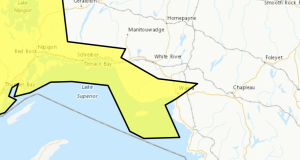 Yesterday, October 21st, 2022 marked 172 years since the Crown acknowledged and committed to protect the rights to land of the Sault Ste. Marie Métis Community in the Robinson-Huron Treaty negotiations. That solemn commitment remains unfulfilled, and reconciliation is stalled without it.
Yesterday, October 21st, 2022 marked 172 years since the Crown acknowledged and committed to protect the rights to land of the Sault Ste. Marie Métis Community in the Robinson-Huron Treaty negotiations. That solemn commitment remains unfulfilled, and reconciliation is stalled without it.
In recognition, the bell in the steeple of the Sault Métis Centre — the former St. John’s Anglican Church — rang 172 times, signifying the 172 years that have gone by since the solemn promise was made to the Métis community at Sault Ste. Marie. Church bells have long been used in Métis communities as messengers, to announce births, deaths and important meetings – and as it has for the past two years – the bell rings as a call to justice.
Canada has long turned a blind eye to these promises but, the Sault Ste. Marie Métis Community has never forgotten.
“We have made significant gains in having our right to self-government recognized and affirmed, but reconciliation is not possible without these issues being addressed. This is a top priority for our community,” said Mitch Case, Métis Nation of Ontario Regional Councillor. “It is fitting that we are advancing our call for reconciliation on Métis land rights in Sault Ste. Marie the home of the Powley case that remains the only Supreme Court of Canada decision affirming Métis rights protected by section 35 of the Constitution Act, 1982.”
Unfortunately, broken promises and the exclusion of the Métis from the Robinson Treaties — despite the Treaty Commissioner’s express recommendation that they be included — is just one story in what has been the common experience of Métis communities of exclusion and marginalization as Canada asserted itself on the land.
“The Crown’s broken promise to protect Métis in Sault Ste. Marie are not the only issues affecting Métis communities stemming from the lack of a Métis Claims Policy at the Federal level.” said Margaret Froh, President of the Métis Nation of Ontario. “Métis in Penetanguishene, Sault Ste. Marie, James Bay and Northwestern Ontario all have outstanding issues to be addressed by the Crown, to say nothing of the significant issues for other Métis communities across the Homeland, such as the fraudulent scrip system in Western Canada.”
“This community needs and deserves a process to resolve this issue, and I would argue that Canada needs it also – if Canada intends to restore its honour and reputation and make true the idea of reconciliation, it needs to sit down with this community, listen to our elders and make good on their promise. It’s time,” said Case.
Background:
As a result of the combined Anishinaabe and Métis rights assertions and action at Mica Bay in 1849, Treaty Commissioner William B. Robinson was appointed by Canada to address Indigenous interests in the region, ultimately leading to the Robinson Treaties being signed in 1850 in order to open the region to legal European settlement and resource extraction.
On September 9th, 1850 Robinson made a promise on behalf of the Crown that the lands along the St. Mary’s River, upon which the Métis community resided, would be respected, and protected. His report and recommendations to the Crown included a promise to protect these Métis lands, which are now downtown Sault Ste. Marie. On October 21st 1850, Robinson formally submitted his report to the Governor General.
Despite Métis pre-existing land interests in the region as well as Crown commitments that those interests would be recognized, the Métis were excluded from the Robinson treaties and suspect land speculation led to the Métis losing their traditional lands along the St. Mary’s River. Notably, Commissioner Robinson, the Crown’s appointed representative and the man who made promises to the Métis on behalf of the Crown, also participated in this land speculation against Métis interests.
In 1850, the Métis submitted a petition, accompanied by a supporting petition from the local Anishinaabek Chiefs, including Shingwaukonse and Nebainagoching, to gain free and full access and possession of their own land. In response, the colonial government designed a scheme that broke their promises, by requiring the Métis to instead purchase the very lands they had lived on for generations and that they were promised “full and free” possession of.
As a result of the government scheme, within 10 years, 90% of the Métis river lots had been lost. In effect, the Crown broke their promise to the Métis as a part of expansion of Canada. As a result, the Métis lost their land base and the social, political, and economic impact of that loss continues to be felt through the generations.
The Federal Specific Claims Policy Act which is relied on by First Nations to advance their historical grievances stipulates that the process is only available to Indian Act Bands, thereby excluding Métis communities, including the Sault Ste. Marie Métis community, from even getting to a table to discuss their historic grievances with the Crown.
- Letter to Doug Ford – Another Devastating Tragedy on Northern Ontario Highway - December 23, 2025
- NAPS lay charges in historic child abuse investigation - December 23, 2025
- Federal Offender arrested in Timmins - December 23, 2025
 Wawa-news.com You can't hear the 'big picture'!
Wawa-news.com You can't hear the 'big picture'!
